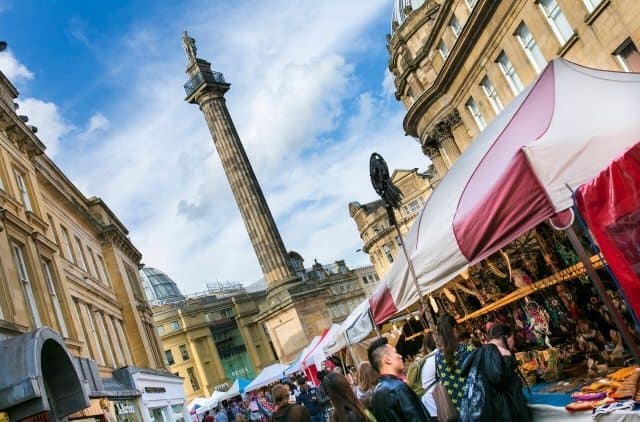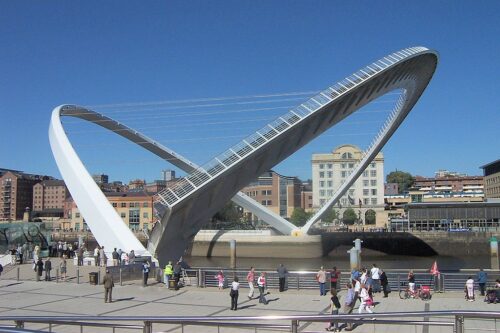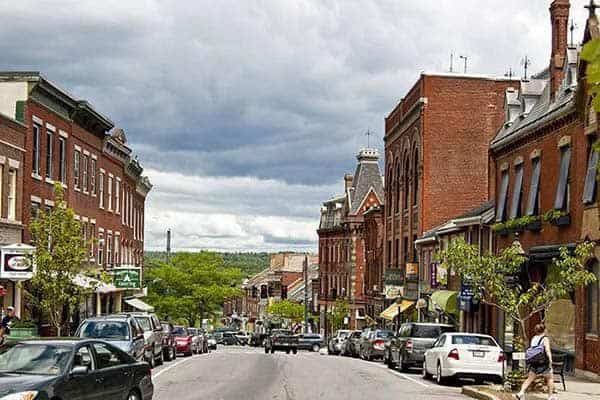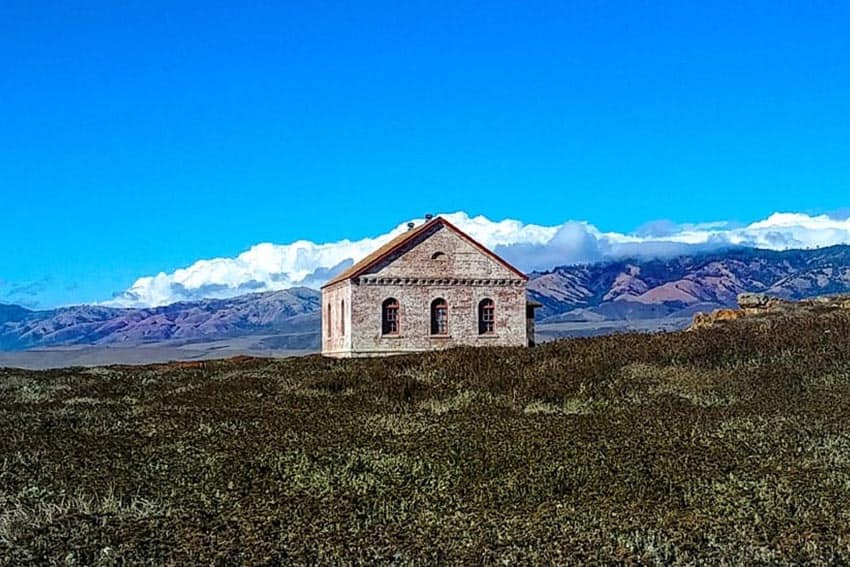
By Janis Turk
Senior Travel Writer

Twice each day the tide sweeps in from the North Sea, covering an ancient causeway leading to Holy Island.
There off the northeastern coast of England, a medieval castle perched high above the waves on a volcanic rock cliff stands near a tiny village and the stone ruins of a 12th-century priory built on the site of a 7th-century Anglo Saxon monastery.
As the tide rises, thousands of seals lie in a great line along a slim sandbar, barking and flapping their fins, appearing to applaud as the sea overtakes the land.
Water envelops the island, cutting it off from the outside world for the next five hours, and from a distance, it seems as though a fairy tale castle has risen from the mist, shrouded in seafoam and mystery.
Bamburgh Castle in Newcastle
Just a few miles down the coastline, another regal fortress, Bamburgh Castle, stands on a hill edged by a small beach. From there, roads shouldered by fields of purple heather dip between deep hills, enchanted Robin Hood-style evergreen forests, and wild craggy Bront-Esque moors.
Fields dotted by sheep are bound by low stone walls, some of which are even the Roman remains of Hadrian’s Wall. Small storybook-style villages divided by gentle streams surround handsome country estates, complete with Downton Abbey-sized English mansions.
At nearby Alnwick Castle, children don the costumes of knights and princesses and play at sword fighting in the very fields where Harry Potter learned to fly on a broomstick.
If this is England you long to see, a mystical Game of Thrones-style land a Camelot-like country found only books and films, you’ll find it in the Northumberland region of northeastern England.

With a short six-hour hour flight from Newark to Newcastle on Tyne, travelers can land in the pulsing heart of Northumbria where their journey begins. Avoiding the madding crowds in London airports and arriving in a smaller, manageable city like Newcastle (population about 250K), visitors can fall asleep on the plane and awake in a land of enchantment.
A good jumping-off point for a journey through Northern England is the clean, contemporary, and centrally located Hotel Indigo, a boutique property offering guests comfortable rooms with bold contemporary design. It’s also a good choice as Hotel Indigo is home to the steakhouse, bar, and grill of celebrity chef Marco Pierre White, a restaurant popular with Geordies (as Newcastle residents are called) and hotel guests, alike.
Sister City-Gateshead
Don’t be in a rush to head north just yet: there’s much to do and see in Newcastle and it’s sister city Gateshead, just across the River Tyne. Begin your English adventure with a heritage, history and culture walking tour led by a friendly local guide who will meet you at your hotel.

Newcastle is probably best known for once being home to coal mining, a ship-building industry and its railroad roots, along with the world-famous Newcastle beer once brewed here; however, these days that’s all gone, and it’s not some gritty industrial place.
Today Newcastle is an architecturally arresting, modern city that is home to ancient castle ruins, large churches,churches, green parks, town squares and statutes, and seven bridges crossing the River Tyne. It’s a town of high-tech businesses, a Nissan factory, and healthy tourism.

It also is home to the impressive St. James Park football stadium (seating 53,000). Strolling along the curved London-like Grey Street and see the ornate Theatre Royal, and visit traditional pubs in Newcastle, but the most impressive attraction in town is the Gateshead Millennium “blinking bridge,” which uses hydraulic engines to hoist up its pedestrian walkway allowing boats to pass.
For a great lunch stop, visit The Herb Garden, Newcastle’s newest pizza kitchen, with space-age-style orb greenhouses herb gardens. For a dynamic dinner with an incredible view, dine at SIX at Baltic, a bright fresh fine-dining eatery on the sixth floor of the Baltic Centre for Contemporary Art, offering panoramic views of the color-changing Millennium Bridge.
Drive the North
When you’re ready to head north to spots along the Northumberland coastline, it is a good idea to hire a knowledgeable guide/driver or rent a car. This is where you will want the mobility of being able to go explore the green hills and moors of the north country.
Crossing the broad sandy causeway to ancient Lindisfarne, known as ‘Holy Island,’ you enter an island that is twice-daily set apart from the rest of the world by fast-moving tides. Both an island and a picturesque village, Lindisfarne carries a wealth of history hidden within its tidal walls.
There guests can visit Lindisfarne Castle and the Lindisfarne Priory, enjoy little tea rooms and shops, and taste Lindisfarne Mead, a sweet local wine made from honey. Then hurry to the mainland before the tide turns for lunch at The Barn at Beal cafe, and watch from the window as water covers the road behind you.

Next. stop and tour Bamburgh Castle. Spanning 9 acres on its rocky plateau above the coastline, it once was home to the kings of ancient Northumbria and is one of northeast England’s most iconic buildings, with parts dating back to the 12th century
From there ride past dramatic hillside scenery to the tiny village of Rothbury on the outskirts of the Northumberland National Park. The River Coquet trips runs through the village beside a small churchyard with old moss and vine-covered headstones.
Enjoy a local brew at an old-style English pub like Turk’s Head and spend the night at the little Queen’s Head Hotel , a traditional pub/inn with an exceptional fine dining restaurant downstairs.
Alnwick Castle
A favorite destination for visitors is always Alnwick Castle, one of the largest inhabited castles in England, owned by the same family for 700+ years. The castle often used as a film location and is best known as the setting for Hogwarts in the first two Harry Potter films, a setting for the movies Elizabeth (with Cate Blanchett) and Robin Hood: Prince of Thieves (Kevin Costner), as well as the setting of the 2014 Christmas episode of Downton Abbey, and many other TV shows.
Last month the Downton Abbey cast filmed another episode in the staterooms (watch season when the family visits a place they call Brancaster Castle). Called the ‘Windsor of the North,’ Alnwick Castle was built as a medieval fortress but today welcomes guests for tours in spring and summer.
Families love it because there are several activities geared to kids. I could spend an entire day at Alnwick Garden, a floral wonderland that features tall bamboo labyrinths, fragrant colorful rose gardens, spraying fountains, manicured hedges, arched walkways shrouded by flowers and thick vines, and more.
Be sure to see the garden Treehouse restaurant as well as the shops and tea rooms in the adjacent village of Alnwick.

Then stay in a Downton Abbey-type mansion at Matfen Hall Hotel, Golf, and Spa, a resort estate about 15 m A hotel since 1999, it was named the 2015 Large Hotel of the Year by the Visit England Awards for Excellence.
A stately mansion set amid 300 acres of park beside a little village, Matfen Hall has 53 bedrooms (many with views of the grounds and gardens), a 27-hole course, par 3 course and driving range, and a large spa, fitness center and heated pool. With inviting dining and sitting rooms, Matfen Hall also has an impressive Grand Hall adorned with stained-glass cathedral windows and a carved wooden staircase.
Favorite spots for hikers and history buffs here are the area’s Hadrian’s Wall World Heritage Sites, with the stone remains of walls, forts, towers and villages dating back to the Roman Empire, like Houseteads Roman Fort and the Vindolanda Chesterholm Museum.
With educational films, ancient artifacts and ongoing archeological digs, well-marked walking paths, and breathtaking scenery, these areas offer adventures that are both educational and awe-inspiring.
With such beauty and treasures at every turn, there are so many reasons to travel north by Newcastle.
Find out more about Newcastle and Newcastle England and North England’s tourism website.
For guided tours of Newcastle and Northumberland, visit the site of Certified Blue Badge Guide Tom Keating.
This adventure was made possible and sponsored in part by Visit Britain, but the opinions are the writer’s alone.
Eurail Passes: What to Know about Buying a Europe Train Pass
- The Maldives: A Blue Beyond Blue - October 3, 2023
- Terceira Island in the Azores, a Magical Mystical Place - December 29, 2021
- Virgin Hotels Dallas: Sir Richard’s Flat - November 18, 2021





